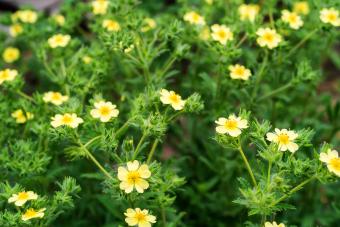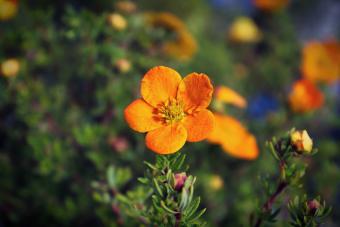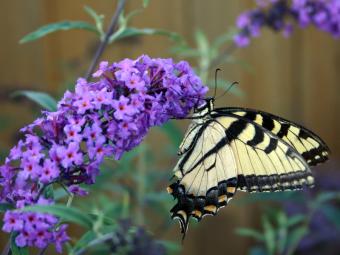
Plentiful, abundant blooms all season long with little to no work? Sounds too good to be true, but if you grow potentilla, also known as cinquefoil, you get all of this and you'll make your local butterflies happy as well.

Growing Potentilla in Your Garden
Potentilla shrubs are available in a wide variety of colors, including yellow, orange, white, red, and pink. They bloom from June until frost, depending on cultivar.
There are potentilla varieties that have compact forms, and you can also find double-flowered varieties as well. Most potentilla shrubs grow from one to four feet tall and about two to four feet wide.
Most varieties of potentilla are hardy in Zones 2 through 6.
Where to Plant Potentilla: Light and Soil Requirements
It's best to plant potentilla, including potentilla fruticosa, in full sun or partial shade--they bloom best if they're in sun most of the day, but get some shade during the hottest part of the afternoon.
Potentilla isn't picky about soil. It, like many plants, grows best in loamy soil, but it also tolerates clay soil and sand fairly well.
Watering and Fertilizing Potentilla
Potentilla prefers even moisture and good drainage, but can tolerate boggy conditions and, once the shrub is established, will endure drought.
As far as when to fertilize potentilla, the best time is in late spring, when you notice the buds starting to swell. The best fertilizers for potentilla are either a topdressing of compost or applying a complete fertilizer according to the package directions. This is the only feeding the potentilla shrub will need for the year.
It's also a good idea to apply a three-inch layer of organic mulch, such as shredded leaves, bark, wood chips, or straw, around the plant (this applies to most garden plants, really.) It will conserve moisture, reduce the amount of weeds you'll have to contend with, and break down over time to add nutrients to the soil.
Pruning Potentilla
Flowers of potentilla fruticosa (and other potentilla plants as well) are produced on the tips of new growth. Gently pruning the shrub after the first bloom will produce more new growth and keep the shrub flowering all summer.
Potentilla can be rejuvenated by pruning the oldest stems back to the ground in late winter. Never remove more than one-third of the shrub. Sometimes potentilla shrubs can take on an awkward, sort of lopsided shape, and rejuvenating them helps avoid this misshapen look.
Potentilla Pests and Diseases
Potentilla is very low maintenance and has few pest or disease issues. Very rarely, fungal issues or aphids might be a problem, but they're usually not a danger to the plant's health.
Propagating Potentilla
The best ways to propagate potentilla are via division and taking cuttings. The method you use will depend on which type of potentilla you're growing in your garden.
- If you're growing perennial, herbaceous potentilla (meaning it doesn't form woody stems and branches, and dies back in the winter), it can be divided in spring. Keeping the soil moist after transplanting the divisions is the most important aspect of making sure the divisions survive.
- If you're growing a shrubby potentilla (meaning it forms woody stems and branches and doesn't die back each winter), softwood cuttings are the way to go. These cuttings can be taken in the summer. You can either pot up the cuttings and let them root and grow in a protected area until next year, or simply stick the cuttings into the soil in your garden and keep them well watered.
13 Beautiful Potentilla Shrubs to Grow in Your Garden
Potentilla shrubs (primarily potentilla fruticosa cultivars) abound in terms of size, color, and foliage. Here are 13 tried and true potentilla shrubs to grow in your garden.
Abbotswood

Potentilla fruticosa 'Abbotswood' is a shrub that is hardy in Zones 3 through 7. It grows approximately two to three feet tall and wide, and has very pretty bluish-green foliage. Its buttercup-like, white blooms are plentiful from June through September.
Coronation Triumph

A shrubby cinquefoil that produces bright yellow blooms all summer long, Potentilla fruticosa 'Coronation Triumph' grows two to four feet tall. It's hardy in Zones 3 through 7. It has a very full growth habit, and its soft green foliage is the perfect backdrop to its prolific blooms.
Daydawn

This perfectly named potentilla fruticosa variety has unique blooms that are a soft shade of yellow near the centers of the blooms, gently transitioning to a rosy pink at the edges. 'Daydawn' is a spreading, shrubby cultivar that grows to about two feet tall. It blooms from June through September and is hardy in Zones 3 through 7.
Fargo

Also known as 'Dakota Sunspot,' which is its registered name, Potentilla fruticosa 'Fargo' is a compact shrub that produces an almost ridiculous number of bright yellow single blooms. It grows to about three feet tall and wide, and is hardy in Zones 2 through 8.
Gibson's Scarlet

If you love red flowers, this is the cinquefoil for you. Potentilla fruticosa 'Gibson's Scarlet' is a bushy perennial potentilla that grows to about one to three feet tall and wide. It's hardy in Zones 5 through 8. It blooms all summer long, forming eye-catching, bright red single flowers that attract butterflies.
Gold Drop

Potentilla 'Gold Drop' is a spreading shrub, growing to around two feet high and three feet wide. It has finely-textured medium green foliage and blooms all summer long, producing small, bright yellow blossoms. 'Gold Drop' is hardy in Zones 2 through 8.
Goldfinger

'Goldfinger' potentilla grows to about four feet tall and wide and blooms from late spring through summer, producing an abundance of bright yellow blooms. In fall, the foliage turns a coppery color that gives another season of color. 'Goldfinger' is hardy in Zones 3 through 7.
McKay's White

If you're looking for a potentilla with white flowers, consider Potentilla fruticosa 'McKay's White,' which has creamy white flowers and grows to about two to three feet tall and wide.
Pink Beauty

'Pink Beauty' potentilla has soft pink flowers and grows about one to four feet tall and two to four feet wide. It develops coppery foliage in fall, and blooms all summer long.
Primrose Beauty

Potentilla 'Primrose Beauty' blooms in a soft shade of yellow (so if you're not a fan of the vibrant yellows common among the potentilla family, this might be a good choice!) It also has bluish-gray, slightly fuzzy leaves. 'Primrose Beauty' grows to about three to four feet tall and wide, making this one of the larger shrubs on this list. It's hardy in Zones 2 through 6, making this an excellent option for cold climates.
Snowbird

Potentilla fruticosa 'Snowbird' is a gorgeous, double-flowered cultivar with pure white blooms and medium green foliage. It has a round, clumping growth habit, growing to about three feet tall and wide.
Sunset

'Sunset' is unique in that the bloom color changes, blooming orange during late spring and early summer, and then fading to yellow blooms as temperatures heat up. It has a dense, compact growth habit, and is hardy to Zone 3.
Uman

Potentilla fruticosa 'Uman,' which is better known under the trademarked name 'Mango Tango,' has striking bicolored yellow and orange blossoms and finely-textured green foliage. It blooms abundantly all summer long and is an excellent choice for low shrubs or along walkways. 'Uman' is hardy in Zones 2 through 7.
What to Plant With Potentilla Fruticosa
If you are planning a butterfly garden, Potentilla should be one of your first choices of plants to include. Potentilla species attract butterflies. The larvae of some species, such as Pavonia pavonia (Emperor Moth) and Pyrgus malvae (Grizzled Skipper), feed on the leaves. A few Lepidoptera species feed exclusively on potentilla, especially Pyrgus cirsii (Cinquefoil Skipper) and Pyrgus bellieri (Foulquier's Grizzled Skipper).
With that in mind, here are some good options for companion plants for potentilla:
Abundant Blooms All Summer Long
If you're looking for a super low-maintenance shrubby plant, a potentilla might be just what your garden needs. Aside from its long, abundant bloom season, it's also a butterfly magnet and is adaptable to a wide range of conditions--not too bad for one little shrub!







